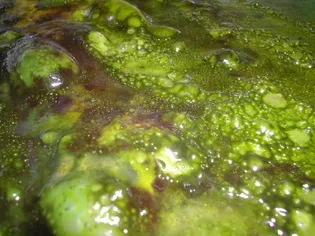Eradicate Slime Algae in an Aquarium
Updated on 04/26/24

Eradicating Slime Algae in Your Aquarium: A Comprehensive Guide
Maintaining a thriving aquarium is an art form that requires dedication and attention to detail. Algae growth is a common challenge, particularly the unsightly slime algae that can mar the beauty of your underwater realm. Fret not, for in this comprehensive guide, we will delve into the depths of slime algae infestation, unravel its causes, and arm you with effective strategies to eradicate this nuisance and restore the pristine clarity of your aquarium.
Understanding Slime Algae
Slime algae, also known as Cyanobacteria, are a type of photosynthetic bacteria that thrive in nutrient-rich environments. Their slimy, gelatinous form clings tenaciously to aquarium surfaces, forming unsightly mats that can suffocate plants and create an unpleasant odor.
Causes of Slime Algae Outbreaks
* Excess Nutrients: Overfeeding your fish, using fertilizers without proper dosing, or neglecting water changes can lead to an accumulation of nutrients that fuels algae growth.
* Inadequate Water Circulation: Poor water flow creates stagnant areas where nutrients and algae can accumulate.
* Insufficient Lighting: Lack of proper lighting can disrupt the balance between algae and beneficial bacteria, promoting the proliferation of Cyanobacteria.
* Old Aquarium Water: Aging aquarium water becomes depleted of essential minerals and accumulates organic waste, providing an ideal environment for slime algae.
Effective Slime Algae Eradication Strategies
1. Water Changes and Nutrient Control:
* Perform regular, partial water changes to remove excess nutrients and maintain optimal water quality.
* Adjust feeding schedules to avoid overfeeding and reduce the accumulation of organic waste.
* Use nutrient-absorbing media, such as activated carbon or phosphate-removing resins, to control nutrient levels.
2. Water Circulation Improvement:
* Install an additional filter or powerhead to increase water flow and eliminate stagnant areas.
* Use a circulation pump to create a gentle current that simulates natural water movement.
* Regularly clean filters and media to maintain optimal water quality.
3. Lighting Optimization:
* Provide adequate lighting for your aquarium, typically 8-12 hours per day.
* Use a timer to regulate lighting duration and ensure a consistent schedule.
* Avoid excessive lighting, as it can stimulate algae growth.
4. Algaecides and Medications:
* Use algaecides specifically designed for Cyanobacteria, following the manufacturer's instructions carefully.
* Antibiotics, such as erythromycin, can be effective in treating severe slime algae infestations.
* Note: Always use chemical treatments as a last resort and follow instructions meticulously to avoid harming fish and other aquarium inhabitants.
5. Natural Remedies:
* Add live plants to your aquarium, as they consume nutrients that would otherwise feed algae.
* Introduce algae-eating fish or invertebrates, such as snails and shrimp, to graze on slime algae.
* Use hydrogen peroxide or Excel (glutaraldehyde) as natural algaecides, but use them judiciously to avoid harming beneficial bacteria.
Prevention is Key
* Regular maintenance: Maintain a consistent water change schedule, check filter performance, and monitor water parameters regularly.
* Avoid overstocking: Overcrowding your aquarium can lead to nutrient overload and algae outbreaks.
* Use bottled water or treat tap water: Tap water may contain nutrients that can promote algae growth.
* Quarantine new plants and fish: Prevent the introduction of algae spores or other potential contaminants.
Example Case Studies
* Case 1: Overfeeding and Insufficient Water Flow
An aquarium owner noticed a rapid increase in slime algae despite performing regular water changes. Upon further investigation, it was discovered that the fish were being overfed, leading to excess nutrients. Additionally, the water flow was inadequate, creating stagnant areas where algae could thrive. By adjusting the feeding schedule and installing an additional powerhead, the slime algae growth was significantly reduced.
* Case 2: Old Aquarium Water and Lack of Lighting
Another aquarium suffered from a persistent slime algae problem. Water testing revealed that the water was old and nutrient-rich. Lighting was also found to be insufficient. By implementing a regular water change schedule, replacing old lighting fixtures with brighter ones, and adding live plants to consume nutrients, the slime algae infestation was eradicated.
Conclusion
Eradicating slime algae in your aquarium requires a multifaceted approach that addresses the underlying causes of the outbreak. By implementing the strategies outlined in this guide, you can restore the health and beauty of your underwater ecosystem. Remember, prevention is key, so regular maintenance and a proactive approach will help you keep algae at bay and enjoy the pristine beauty of your aquarium for years to come.
Explore More Pets

Freshwater Aquarium Filters
How to Deal With Cloudy Aquarium Water

Saltwater Aquarium Filters
How Do You Remove Chloramines From Tap Water?

Freshwater Aquariums & Habitat
Can I Keep My Koi Fish Inside?

Saltwater Aquariums & Habitat
14 Best Floating Plants for Your Aquarium

Freshwater Fish Health
How to Treat Ich on Freshwater Fish

Saltwater Fish Health
Fin Rot in Aquarium Fish

Freshwater Aquarium Filters
How to Do Aquarium Water Changes

Saltwater Fish Health
How Do Fish Get Parasites?